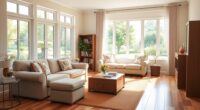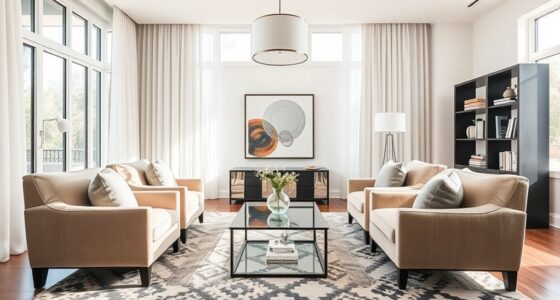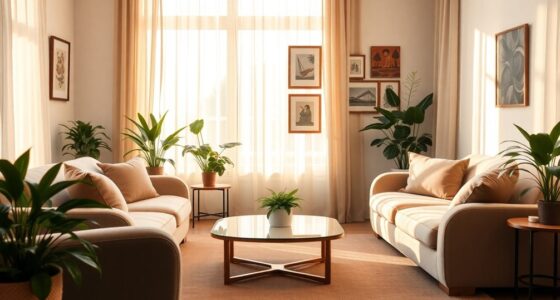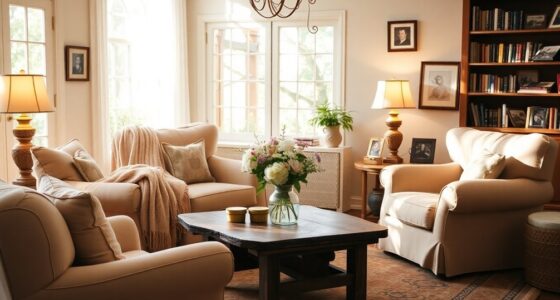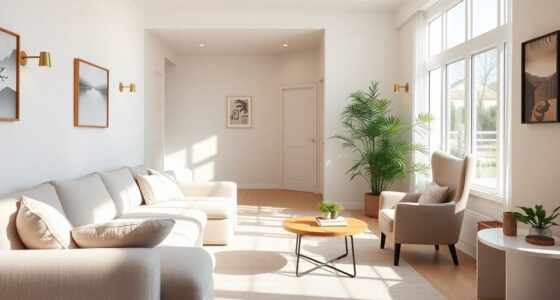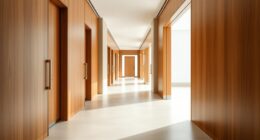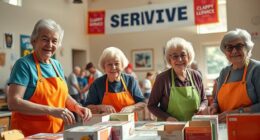To boost comfort and style for the elderly in your home, start by prioritizing universal design principles. Create safe entryways with good lighting and non-slip surfaces. Enhance mobility by opting for lever handles and removing tripping hazards. Make bathrooms accessible with grab bars and walk-in showers. In the kitchen, use pull-out shelves and easy-to-use faucets. Guarantee living areas have adjustable lighting and comfortable, appropriately sized furniture. Explore more ideas to create a truly inviting home.
Key Takeaways
- Choose furniture with the right height (18-20 inches) to facilitate easy sitting and standing for elderly individuals.
- Incorporate non-slip flooring materials throughout the home to enhance safety and reduce fall risks.
- Use adjustable lighting options to create a warm atmosphere and improve visibility in all areas.
- Design clear pathways with a minimum width of 36 inches to prevent tripping hazards and accommodate mobility aids.
- Select colors with good contrast to aid depth perception and make navigation easier for seniors.
Understanding the Principles of Universal Design for Home Modifications
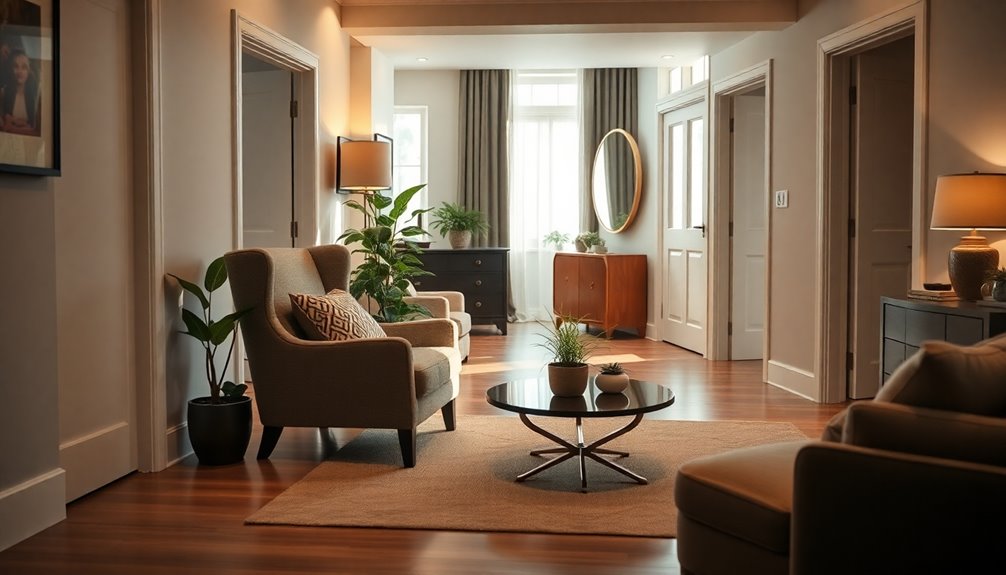
When considering home modifications for elderly comfort, understanding the principles of universal design is essential. This approach prioritizes accessibility in mind, ensuring that spaces are usable by everyone, regardless of age or ability.
Key principles include equitable use, flexibility in design, and simplicity, which enhance usability. By incorporating perceptible information and minimizing physical effort, you'll create an environment that promotes both comfort and safety.
Effective home modifications focus on the unique needs of aging residents while remaining functional for all users. By embracing these universal design principles, you can greatly improve the quality of life for elderly individuals living independently, making their homes more welcoming and supportive for years to come.
Creating Safe and Accessible Entryways for the Elderly
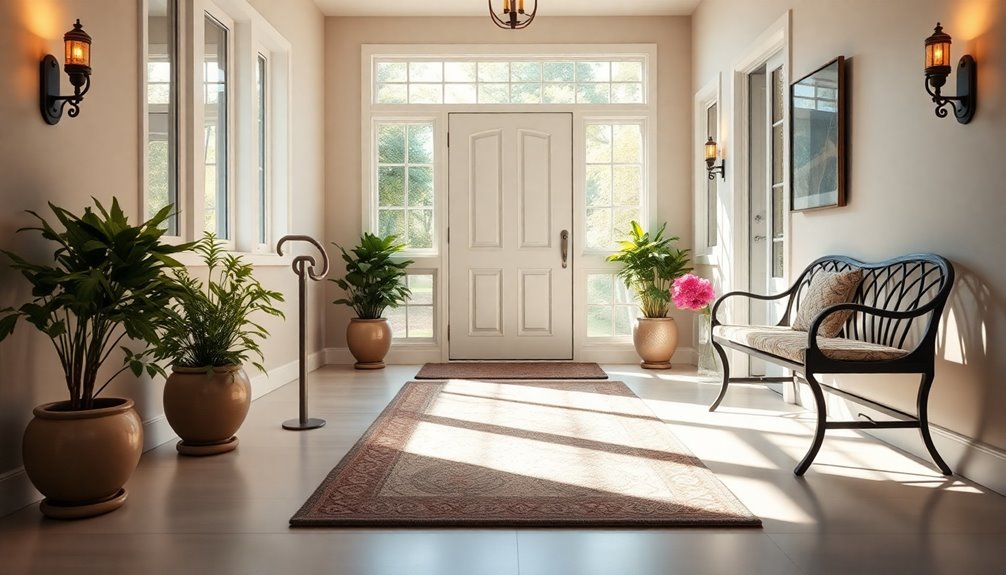
Creating a safe and accessible entryway is essential for enhancing the comfort of elderly residents. To guarantee a smooth shift into the home, focus on the following key elements:
- Proper lighting: Brighten up entryways to enhance visibility, reducing the risk of accidents.
- Non-slip surfaces: Use flooring materials that prevent slips, especially in wet or snowy conditions.
- Grab bars: Install these for added support and stability when entering or exiting.
Consider clear pathways and unobstructed entryways to facilitate wheelchair access.
Adding convenient landing spots for items like keys or mail can also help prevent fumbling, promoting a smoother experience. Additionally, ensuring that the entryway is well-insulated can contribute to heat pump efficiency, maintaining a comfortable indoor temperature year-round.
These modifications not only boost comfort but also guarantee safety for elderly residents and their visitors.
Enhancing Mobility Throughout the Home

To enhance mobility throughout the home, focus on making simple modifications that promote ease of movement for elderly residents.
Upgrade to lever handles on doors, allowing for easier operation without requiring fine motor skills.
Choose slip-resistant flooring materials, like anti-skid tiles, to improve safety and reduce fall risks.
Remove or secure area rugs to eliminate tripping hazards, creating a safer environment.
Make certain to eliminate thresholds between rooms for smoother shifts, especially for wheelchair users.
Additionally, guarantee clear pathways and adequate space between furniture to reduce obstacles.
Designing Elder-Friendly Staircases

Staircases can pose significant challenges for elderly individuals, especially in homes designed for multi-level living.
To enhance home safety and guarantee comfortable living, consider the following tips:
- Handrails should be installed on both sides of the staircase for support and stability.
- Optimize stairway lighting with bright, glare-free fixtures to improve visibility and reduce the risk of falls.
- Use contrasting colors for handrails and stair treads to aid depth perception.
Additionally, assess the integrity of handrails and stair surfaces regularly, and consider installing stairlifts if necessary. Incorporating natural materials like wood can also enhance both safety and the overall aesthetic of the staircase.
These measures will help create a safer environment, allowing seniors to navigate stairs with confidence and ease.
Prioritizing these design elements guarantees your home remains both stylish and functional for aging residents.
Adapting Bathrooms for Increased Safety for the Elderly
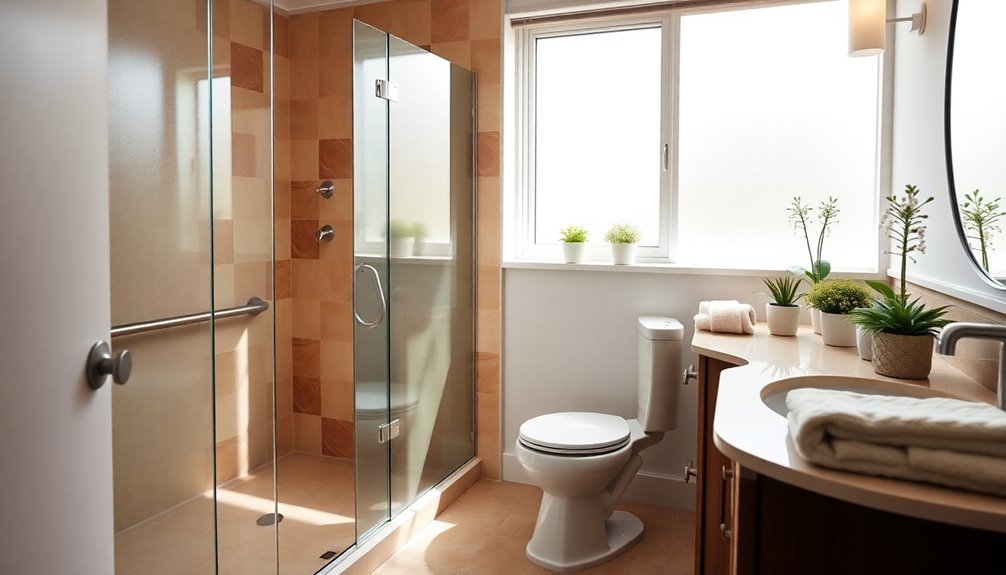
When adapting bathrooms for increased safety, you'll want to focus on essential grab bar placement and safe shower solutions.
Installing grab bars near toilets and in the shower provides vital support, while a walk-in shower can eliminate tripping hazards.
Choosing non-slip flooring is also key to reducing fall risks in wet areas. Additionally, regular maintenance of toilets can prevent unexpected issues that may pose a safety risk.
Essential Grab Bar Placement
Installing grab bars in the bathroom is an essential step for enhancing safety and comfort for the elderly. Proper placement guarantees peak support during critical changes, like entering or exiting the shower or sitting on the toilet.
Aim for a height of 33 to 36 inches, and consider these tips:
- Install grab bars in the shower, bathtub, and near the toilet for maximum safety.
- Choose contrasting colors for grab bars to enhance visibility, making them easier to locate.
- Conduct regular maintenance checks to guarantee stability, as wear or looseness can compromise this critical safety feature.
Securely anchored, non-slip grab bars provide greater stability than suction cup models, giving peace of mind to both seniors and caregivers alike. Additionally, ensuring a clean and well-maintained environment can significantly reduce the risk of slips and falls in the bathroom.
Safe Shower Solutions
To further enhance bathroom safety for the elderly, consider implementing safe shower solutions that prioritize accessibility and comfort. Start with zero-threshold showers to minimize slip risks. Incorporate grab bars in key spots, like inside the shower and near the toilet, for added support. Non-slip flooring is essential; choose materials designed for wet areas to improve traction. Handheld showerheads provide flexibility, allowing seniors to bathe comfortably while reducing fall risks. Finally, install shower controls with lever-style handles that are easy to reach and operate, especially for those with limited dexterity. Additionally, it's important to consider monitoring financial accounts for unusual activity related to home modifications, ensuring that any investments in safety features are both effective and secure.
| Safe Shower Solutions | Benefits |
|---|---|
| Zero-threshold showers | Seamless access, reduced slips |
| Grab bars | Essential support and stability |
| Non-slip flooring | Improved traction and safety |
| Handheld showerheads | Greater flexibility and ease |
| Lever-style handles | Enhanced usability for seniors |
Optimizing Lighting for Aging Eyes
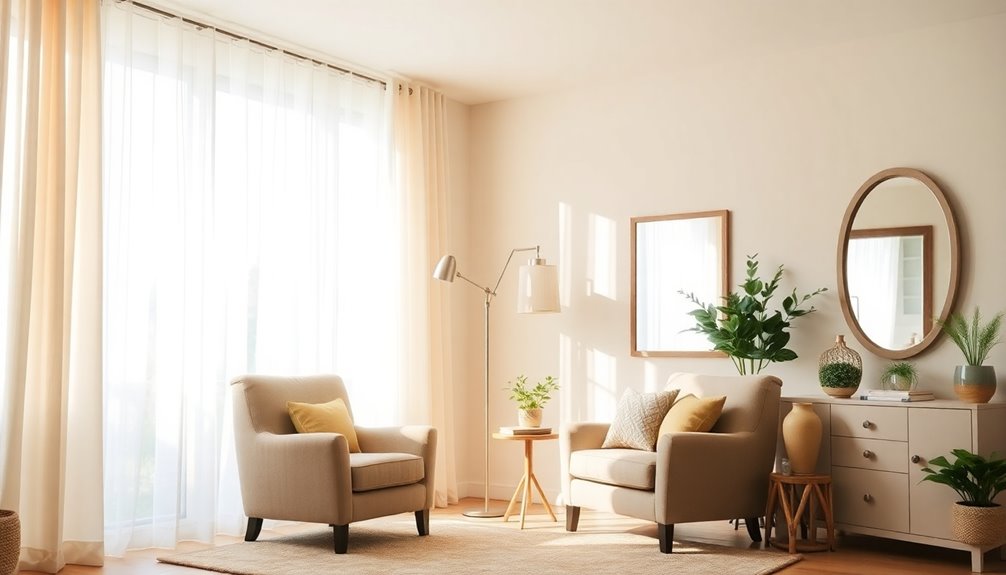
To make your home safer and more comfortable for aging eyes, focus on bright, glare-free lighting throughout the space.
Incorporating task lighting in areas where you read or cook can greatly enhance visibility, while motion-sensor lights in high-traffic zones guarantee you navigate safely at night. Additionally, consider using air purifiers to improve indoor air quality, which can further contribute to a healthier living environment for seniors.
Bright, Glare-Free Lighting
While it's easy to overlook, proper lighting plays an essential role in enhancing comfort and safety for elderly individuals.
Bright, glare-free lighting is vital for aging eyes, as it improves visibility and reduces strain.
Consider these tips to create a safe and accessible environment:
- Use cool white lights rather than yellow ones to enhance visibility.
- Install motion-sensor lights in high-traffic areas to illuminate pathways automatically.
- Place night lamps strategically to prevent accidents during nighttime trips.
Additionally, utilizing AI tools can help identify the best lighting solutions tailored to the specific needs of elderly individuals.
Task Lighting Importance
Bright, glare-free lighting sets the stage for a safe and comfortable home, but task lighting takes it a step further by focusing on specific activities.
For older adults, task lighting is essential in areas like reading nooks or kitchens, enhancing visibility and reducing eye strain. By using bright, cool white light instead of yellow, you improve contrast, making it easier to navigate spaces.
Confirm adequate task lighting over workspaces, such as countertops and tables, to support activities like cooking or crafting. This not only promotes safety but also enjoyment. Additionally, consider using eco-friendly paints that reflect light better and contribute to a healthier environment.
Motion-Sensor Light Benefits
As you optimize your home for comfort, consider the advantages of motion-sensor lights, which can transform how you navigate your space.
These lights automatically illuminate areas when you approach, making it easier to avoid stumbling in the dark. They greatly enhance safety by providing visibility in high-traffic zones, reducing the risk of falls.
- They improve lighting in critical areas like hallways and bathrooms.
- Programmable timers conserve energy while ensuring you have light when needed.
- They promote independence, allowing for safer nighttime trips without disturbing others. Proper installation and venting are essential to ensure that these lighting solutions operate safely and effectively in your home.
Improving Kitchen Safety and Usability
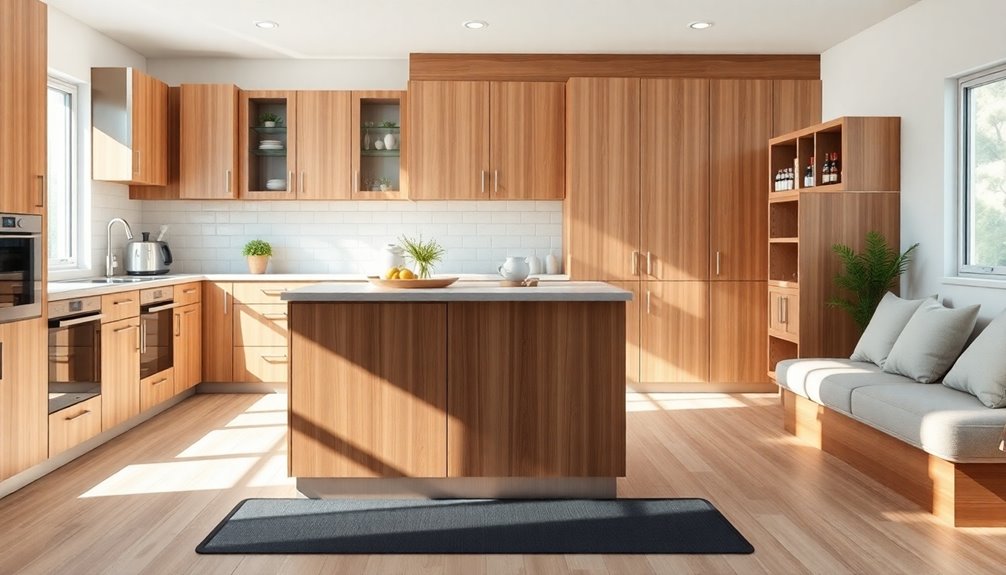
Creating a safe and user-friendly kitchen is essential for elderly individuals, especially since it can be one of the most active areas in the home.
To enhance accessibility, utilize pull-out shelves and drawers, minimizing the need for bending or reaching. Install lever-style faucets for greater ease of use, particularly for those with limited hand strength.
Adequate, glare-free lighting in workspaces reduces the risk of accidents while cooking. An open kitchen layout promotes smooth movement, beneficial for those using mobility aids.
Finally, non-slip flooring materials guarantee safety by preventing slips and falls.
Creating Comfortable Living Spaces
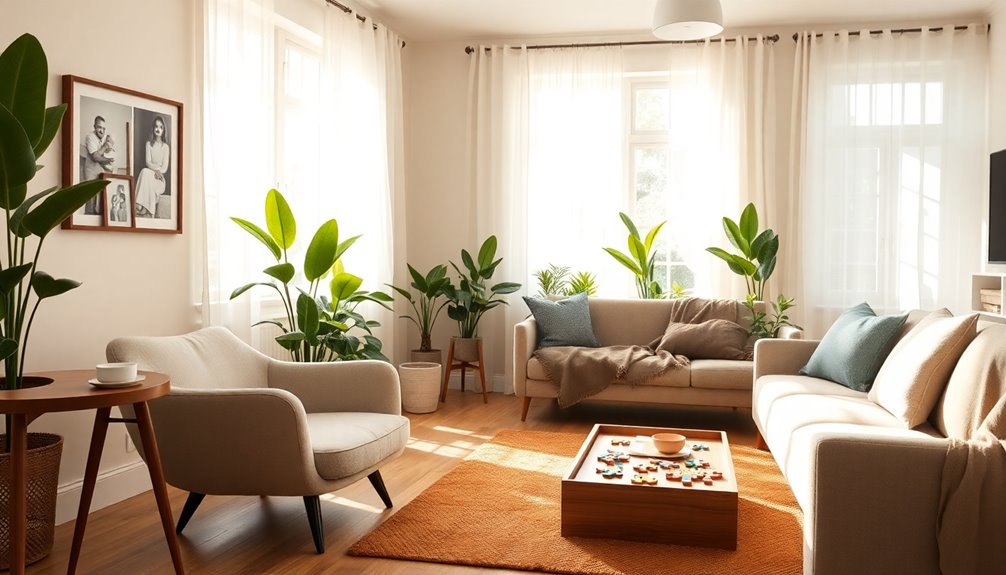
To guarantee comfort in living spaces for the elderly, it's essential to prioritize thoughtful design choices that enhance both functionality and aesthetics.
Start by selecting furniture with appropriate heights—aim for 18-20 inches for chairs—to make sitting and standing easier. Use non-slip mats to provide cushioning while reducing fall risks.
Ensure clear pathways throughout the space, with a minimum width of 36 inches, to prevent tripping hazards.
Consider these tips for creating comfortable living spaces:
- Arrange seating to encourage social interaction, fostering community.
- Incorporate adjustable lighting options to create a warm atmosphere.
- Use soft, non-slip rugs to enhance comfort and safety.
With these strategies, you'll create inviting and functional spaces for the elderly.
Enhancing Outdoor Spaces for Accessibility
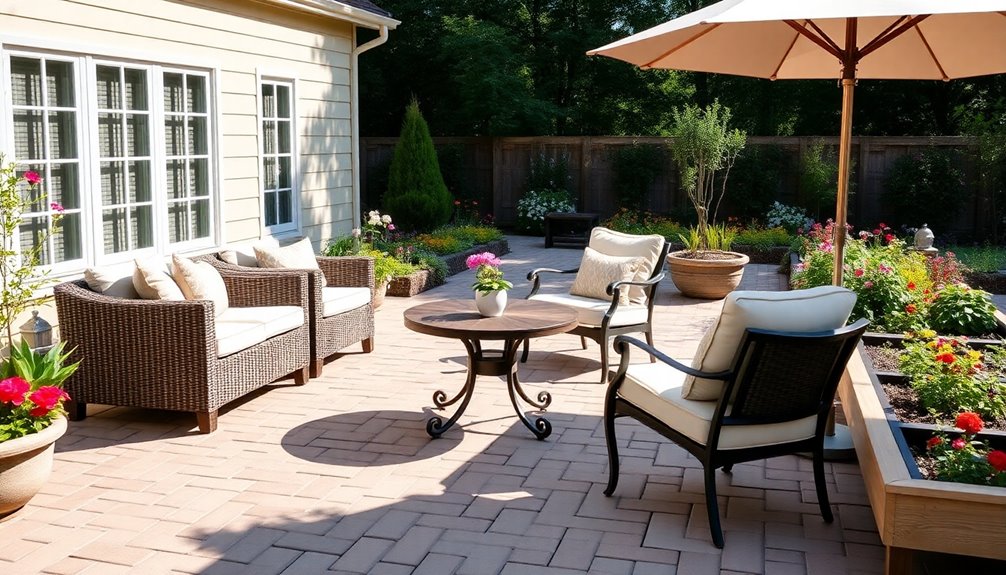
When enhancing outdoor spaces for accessibility, focus on creating safe pathways and comfortable seating areas. You'll want to guarantee that landscaping features are easy to navigate, minimizing obstacles for those with mobility challenges. With thoughtful design, you can transform your outdoor areas into welcoming environments that promote relaxation and safety. Additionally, incorporating durable materials ensures that your outdoor space remains functional and appealing for years to come.
Safe Pathway Design
Designing safe pathways is essential for ensuring that outdoor spaces are accessible to everyone, especially the elderly. Prioritizing safety enhances their mobility and confidence.
Here are key elements to evaluate for effective safe pathway design:
- Non-slip surfaces: Use materials that prevent slips, especially in wet conditions.
- Adequate lighting: Install lights along pathways to improve visibility at night, reducing the risk of accidents.
- Gentle slopes: Incorporate ramps and gentle slopes to facilitate easy access between different levels.
Additionally, maintain outdoor areas regularly to eliminate tripping hazards like debris or obstacles.
Comfortable Seating Areas
Creating comfortable seating areas outdoors makes a significant difference in how elderly individuals enjoy their surroundings. By incorporating comfortable seating with armrests, you can provide support that makes standing up easier, promoting independence and enhancing their overall experience.
Thoughtful design should also focus on arranging seating to facilitate conversation and social interaction, allowing seniors to connect with guests effortlessly. Additionally, use non-slip surfaces around these areas to minimize fall risks, creating a safer environment.
Choose weather-resistant materials for durability and ease of maintenance, ensuring accessibility year-round. Finally, including shaded areas or canopies protects elderly individuals from direct sunlight, promoting comfort and reducing the risk of heat-related illnesses during outdoor activities.
Accessible Landscaping Features
To enhance outdoor spaces for accessibility, incorporating thoughtful landscaping features makes a world of difference for elderly individuals.
You can create a safe and inviting environment by focusing on a few key elements.
- Use ramps with gentle slopes to guarantee wheelchair access, enhancing mobility.
- Install non-slip surfaces for patios and walkways to prevent slips and falls.
- Provide comfortable seating with armrests to support seniors while sitting or standing.
Additionally, guarantee clear obstacle-free pathways to facilitate navigation and encourage outdoor activity.
Well-lit areas with motion-sensor lighting can further improve visibility during nighttime outings.
Incorporating Technology for Safety and Convenience
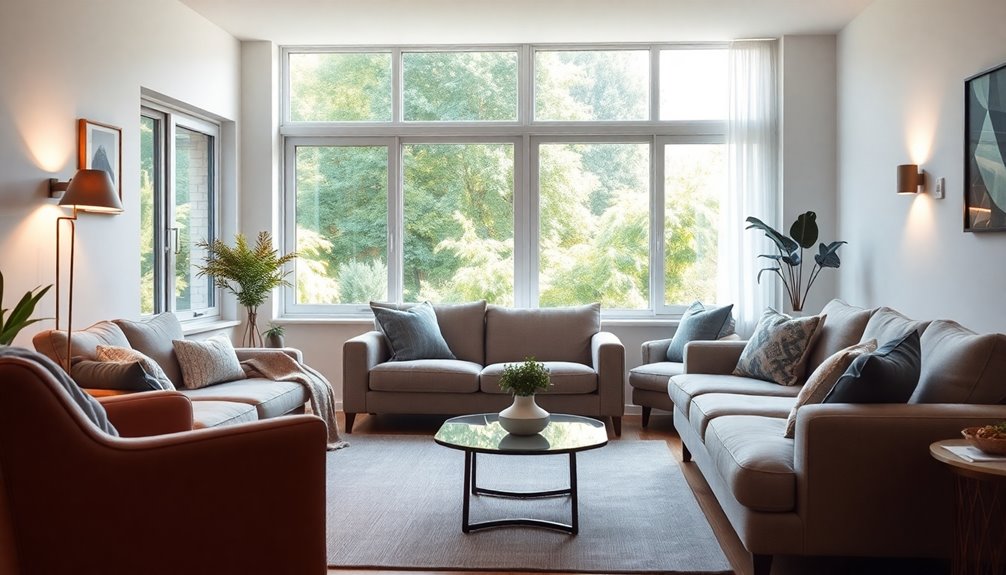
As you consider ways to enhance safety and convenience for elderly loved ones, incorporating smart home technology can make a significant difference.
Start by installing security cameras and motion sensors to monitor activity, alerting you to any unusual behavior. Automated lighting systems, especially motion-sensor lights, illuminate pathways and reduce fall risks during nighttime.
Medical alert systems guarantee seniors can quickly call for help in emergencies, improving response times. Additionally, remote-controlled devices like door locks and thermostats offer convenience, allowing them to manage their environment effortlessly.
Voice-activated assistants simplify daily tasks, enabling hands-free control of lights and appliances, which is perfect for those with limited mobility.
Frequently Asked Questions
What Is the 70/30 Rule in Interior Design?
The 70/30 rule in interior design is a guideline that helps you create a balanced and cohesive space.
You'll want to dedicate 70% of your room to a primary design style or color scheme, while the remaining 30% can be used for accents and complementary elements.
This approach keeps the aesthetic pleasing and uncluttered, allowing key features like furniture or artwork to shine without competing styles overwhelming the overall look.
What Is the 60/40 Rule in Interior Design?
The 60/40 rule in interior design suggests you should divide your room's elements into two main portions: 60% of one dominant style or color and 40% of complementary items.
This balance creates a harmonious space without overwhelming it. You can use the 60% for larger furniture or wall colors, while the 40% can include decor and accessories that enhance your theme.
This approach allows you to personalize your space while maintaining visual cohesion.
How to Design a Room for the Elderly?
Designing a room for the elderly can feel like a balancing act, much like trying to juggle while riding a bike!
You'll want to select furniture that's easy to get in and out of, ideally at 18 inches high.
Opt for lever handles for doors and drawers, and keep pathways clear to avoid tripping.
Non-slip rugs and bright, glare-free lighting can make a significant difference in safety and comfort.
Everyone deserves a cozy, accessible space!
What Is the 2/3 Rule in Interior Design?
The 2/3 Rule in interior design suggests that you should fill about two-thirds of a room with furniture while leaving ample open space for movement.
This approach not only balances aesthetics but also guarantees accessibility, especially for those with mobility challenges.
Conclusion
By embracing these top interior design tips, you can transform your home into a haven of comfort and style for elderly loved ones. With a few thoughtful modifications, you’ll create a space that’s not just safe but also as inviting as a five-star resort. Remember, it’s all about balance—functionality and aesthetics go hand in hand. So, roll up your sleeves and start designing a space that truly enhances their quality of life! Incorporating natural light and soft textures can further elevate the ambiance, making every room feel warm and welcoming. Additionally, when using revamp your living space tips, consider incorporating multifunctional furniture that can adapt to various needs, ensuring ease of movement and access. By focusing on both safety and visual appeal, you’ll create an environment that not only looks beautiful but also fosters independence and well-being.

